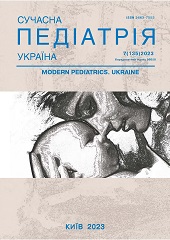Rare forms of eye lesions in Lyme disease in children
DOI:
https://doi.org/10.15574/SP.2023.135.145Keywords:
Lyme disease, children, borreliosis, ELISA, immunoblot, tick bite, uveitisAbstract
Lyme disease (LD) is a multisystem disease caused by Borrelia burgdorferi and other similar tick-borne borrelia.
Purpose - to analyse and present clinical cases of eye lesions in children with suspected LD for differential diagnosis and treatment refinement.
We present 2 clinical cases with ocular lesions in children of infectious genesis with suspected LD. Basic examinations, ophthalmoscopy, optical coherence tomography with angiography, clinical and immunological tests, including ELISA and immunoblot, were performed. Serological results were compared in children with different forms of eye lesions of infectious genesis.
Conclusions. The diagnosis of LD should be confirmed by laboratory tests (ELISA and western blot serological tests), indicating the presence of specific anti Borrelia burgdorferi IgM/IgG antibodies, and confirming the clinical manifestations of the disease. Paediatricians should be alert to LD, especially in residents of endemic areas. The need for prophylactic treatment of LD in children exposed to tick bites has been proven. The diagnosis of LB in children should be laboratory confirmed by a two-step method (ELISA serological tests and western blot), which confirms the clinical manifestations of the disease.
The study was performed in accordance with the principles of the Declaration of Helsinki. Informed consent of parents and child was obtained for the study.
No conflict of interests was declared by the authors.
References
Berglund J, Eitrem R, Ornstein K et al. (1995). An epidemiologic study of Lyme disease in southern Sweden. English Medical Journal. 333; 20: 1319-1327. https://doi.org/10.1056/NEJM199511163332004; PMid:7566023
Bray L, Jeffries M. (2022, Sep 28). P45 Lyme-associated uveitis: Panuveitis and positive Lyme results - is it a masquerade or the real deal? Rheumatol Adv Pract. 6 (1): rkac067.045. https://doi.org/10.1093/rap/rkac067.045; PMCid:PMC9515823
Caulfield AJ. Pritt BS. (2015). Lyme disease coinfections in the United States. Clin. Lab. Med. 35; 4: 827-846. https://doi.org/10.1016/j.cll.2015.07.006; PMid:26593260
Centers for Disease Control and Prevention. (1995). Recommendations for test performance and interpretation from the Second National Conference on Serologic Diagnosis of Lyme Disease. MMWR Morb Mortal Wkly Rep. 44: 590-591.
Engstrom SM, Shoop E, Johnson RC. (1995). Immunoblot interpretation criteria for serodiagnosis of early Lyme disease. J Clin Microbiol. 33(2): 19-22. https://doi.org/10.1128/jcm.33.2.419-427.1995; PMid:7714202 PMCid:PMC227960
Esposito S, Bosis S, Sabatini C et al. (2013). Borrelia burgdorferi infection and Lyme disease in childrenю International Journal of Infectious Diseases. 17; 3: 153-158. https://doi.org/10.1016/j.ijid.2012.09.014; PMid:23141587
Huppertz HI, Bartmann P, Heininger U et al. (2012). Nentwich Rational diagnostic strategies for Lyme borreliosis in children and adolescents: recommendations by the Committee for Infectious Diseases and Vaccinations of the German Academy for Pediatrics and Adolescent Health. Eur. J. Pediatr. 171: 1619-1624. https://doi.org/10.1007/s00431-012-1779-4; PMid:22782450 PMCid:PMC3491193
Kopcha VS ta in. (2016). Diahnostychni mozhlyvosti imunnoho blotynhu pry boreliozi. URL: https://health-ua.com/article/6780-dagnostichn-mozhlivost-munnogo-blotingu-pri-boreloz.
McCarthy CA, Helis JA, Daikh BE. (2022). Lyme Disease in Children, Infectious Disease Clinics of North America. 36 (3): 593-603. ISSN 0891-5520, ISBN 9780323972925, https://doi.org/10.1016/j.idc.2022.03.002; PMid:36116837
Moore A, Nelson C, Molins C et al. (2016). Current guidelines, common clinical pitfalls, and future directions for laboratory diagnosis if Lyme disease, United States. Emerging Infectious Diseases. 22; 7: 1169-1177. https://doi.org/10.3201/eid2207.151694
MOZ Ukrainy. (2007). Protokol nadannia medychnoi dopomohy khvorym z irydotsyklitom (irytom, irydotsyklitom, uveitom). Dodatok do nakazu MOZ Ukrainy vid 15.03.2007 No. 117.
Nykytyuk S, Klymnyuk SI, Levenets S. (2019). Laboratory diagnostics of lyme borreliosis in children with ticks bites in Ternopil region. Georgian medical news. 11(296): 32-36.
Osikowicz LM, Rizzo MR, Hojgaard A, Maes SE, Eisen RJ. (2023). Detection of Borrelia burgdorferi sensu lato species in host-seeking Ixodes species ticks in the United States, Ticks and Tick-borne Diseases. 15: 102270. ISSN 1877-959X. https://doi.org/10.1016/j.ttbdis.2023.102270; PMid:37813001
Park BH, Kwon HJ, Park SW, Lee JE, Byon I. (2023). A Case of Lyme Disease Presenting as Bilateral Panuveitis. Ocular Immunology and Inflammation. https://doi.org/10.1080/09273948.2023.2231534
Shapiro ED. (2014). Lyme Disease. The new england journal of medicine. 370: 1724-1731. https://doi.org/10.1056/NEJMcp1314325; PMid:24785207 PMCid:PMC4487875
Stanek G, Wormser GP, Gray J, Strle F. (2012). Lyme borreliosis. Lancet. 379: 461-473. https://doi.org/10.1016/S0140-6736(11)60103-7; PMid:21903253
Steere AC. (2001). Lyme disease. N. Engl. J. Med. 345; 2: 115-125. https://doi.org/10.1056/NEJM200107123450207; PMid:11450660
Voulgari N, Blanc CM, Guido V, Rossi DC, Guex-Crosier Y, Hoogewoud F. (2021, Aug 28). Tick-borne encephalitis related uveitis: a case report. BMC Ophthalmol. 21(1): 315. https://doi.org/10.1186/s12886-021-02068-1; PMid:34454464 PMCid:PMC8403360
Wormser GP et al. (2006). The clinical assessment, treatment, and prevention of Lyme disease, human granulocytic anaplasmosis, and babesiosis: clinical practice guidelines by the Infectious Diseases Society of America. Clin Infect Dis. 43; 9: 1089-1134. https://doi.org/10.1086/508667; PMid:17029130
Downloads
Published
Issue
Section
License
Copyright (c) 2023 Modern pediatrics. Ukraine

This work is licensed under a Creative Commons Attribution-NonCommercial 4.0 International License.
The policy of the Journal “MODERN PEDIATRICS. UKRAINE” is compatible with the vast majority of funders' of open access and self-archiving policies. The journal provides immediate open access route being convinced that everyone – not only scientists - can benefit from research results, and publishes articles exclusively under open access distribution, with a Creative Commons Attribution-Noncommercial 4.0 international license (СС BY-NC).
Authors transfer the copyright to the Journal “MODERN PEDIATRICS. UKRAINE” when the manuscript is accepted for publication. Authors declare that this manuscript has not been published nor is under simultaneous consideration for publication elsewhere. After publication, the articles become freely available on-line to the public.
Readers have the right to use, distribute, and reproduce articles in any medium, provided the articles and the journal are properly cited.
The use of published materials for commercial purposes is strongly prohibited.

